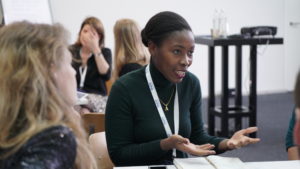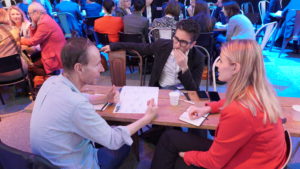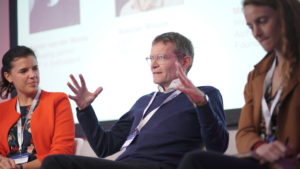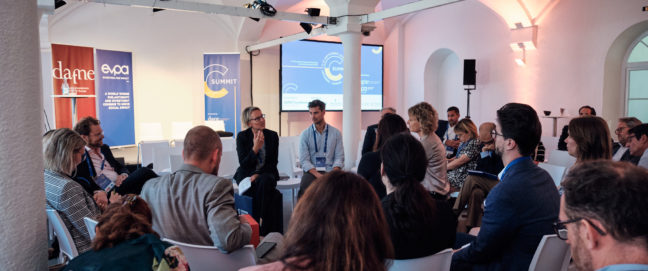There were a number of special guests at the 15th EVPA annual conference, Celebrating Impact, in the Hague last week. In no order of precedence they were the city’s mayor, four of the five founders of the Association and HRH Queen Máxima of the Netherlands. Her Majesty’s appearance caused an unwonted fuss – not from her, nor from the organisers but from the press and TV corps whose representatives hurtled in in a body, almost bumping into latecomers who were being urged with more than usual energy by the front-of-house volunteers to take their places. She herself took her seat among the 750 delegates almost without anyone being aware of it, She posed for a photo with EVPA CEO, Steven Serneels, to launch EVPA’s impact investing charter, but to the surprise of many I talked to later, spoke not a word and entered and left a number of sessions in the same low key.
The founders (the absentee of the original five was Luciano Balbo, who was unwell) were more forthcoming. Venture philanthropy might sound like a remote concept, said Stephen Dawson but really ‘it’s about people.’ The others agreed and while EVPA has made progress since the preliminary meeting round Dawson’s dining room table, Doug Miller cautioned that ‘the problems we are chasing are moving faster,’ and he pleaded for an increased sense of urgency.
Energy and purpose
It’s notable that the range of EVPA’s activities has expanded from the early days. The opening video talked of investment mobilised for forests, for oceans, for democracy, in addition to more tangible mainstay issues such as housing and healthcare. Jamy Goewie spoke of the quest for peace and justice, Steven Serneels, of putting beneficiaries at the centre and of tackling the roots of problems, rather than just their symptoms. While all these things might have been implicit in EVPA’s previous work, they have seldom been stressed in this way.
That wasn’t the only difference from other EVPA conferences I’d been to. There was greater energy about the proceedings and – although this might be a false impression created by my own advancing age – it seemed to me that delegates were on average more youthful, an idea reinforced by the fact that the topic of at least one breakout session had a ‘next gen’ theme. One of these, led by a panel of young social investment intermediaries asked what social investing looks like through the eyes of the next generation. Moderator Christina Wu of EVPA cited statistics estimating that by 2025, 75 per cent of the workforce will be made up by ‘millennials’, 78 per cent of those aged 18-36 already make social investments of some kind or plan to, and a similar percentage say that, if a company makes social or environmental claims, it will investigate them. In other words, the next generation is different.
While the social investment sector is attracting growing interests from undergraduates and graduates, there are few ways of entry particularly into the social enterprise intermediary sector
The panel, however, felt that things are moving more slowly than statistics might suggest. Though the next generation will sooner or later control big money, at the moment. ‘old’ money can be hard to move. Marika Bernhard from the Bosch Foundation said that Bosch is moving into social investments but progress is hindered by the lack of in-house capacity. It’s vital, she believes, to get more people into philanthropy with experience of social enterprise because there is still a big gap between the two. Aimee van der Wolde of SEIF in Switzerland also noted a capacity issue and called for more capacity building programmes on social investment.
What is missing in the Netherlands believes Björn Vennema of Social Finance NL, is a way to bridge the gap between the social and financial sectors, since few have a firm grasp of both. Marika Bernhard sees a gap but for her, it is one between types of investor. There are those principally interested in financial return and those whose main concern is environmental and social returns (in the shorthand of the conference, ‘impact’). Björn Vennema and Louis Wouters of LITA.co, also from Belgium agreed that, while the social investment sector is attracting growing interests from undergraduates and graduates, there are few ways of entry particularly into the social enterprise intermediary sector (advisers, trainers, those who can match investors with investees) for young people.
What can be done? EVPA could become the forum for Next Gen’s views on social investing and for fostering the idea that there should be no distinction between investing and social investing – social investing is ‘no longer a niche, it’s what you do’.
 Where and why does social enterprise prosper?
Where and why does social enterprise prosper?
Social enterprise does better in some countries than in others but, perhaps more surprisingly, the countries where it prospers are not always the same ones over time. Shiura Rasheed of the Thomson Reuters Foundation talked about a survey her organisation had carried out in conjunction with Deutsche Bank’s Made for Good programme, assessing conditions for social enterprises across a number of key variables such as the legal environment, access to investment and public understanding. The initial survey in 2016 had the US and the UK in the top 10, the US at number one. In this year’s results, both had dropped out of the leaders to be replaced by the likes of Canada, Indonesia and Chile. The discussion revealed a number of things: while social enterprise enjoys a specific legal form in the UK and US, public visibility is low and social enterprises are not good at publicising themselves. Ultimately, suggest the survey findings, the critical conditions for social enterprises to thrive are supportive government policy and access to investment.
Beneficiaries first
The importance of beneficiaries’ views, an idea voiced by Steven Serneels and endorsed in the impact investment charter, was the subject of a number of sessions. Listening to the voices of ultimate beneficiaries can pay dividends for funders – it provides a greater degree of legitimacy to their investments and it promotes agency in the beneficiary group, yet few do it, said Cliff Prior of Big Society Capital. A few common reasons are alleged: ‘it’s too expensive’, ‘it’s too complicated’, ‘we have no expertise’, ‘isn’t that the grantees job?’ Perhaps the first obstacle, though, is that funders are two removes away from beneficiaries, so any assessment needs the cooperation of the grantees and they can be reluctant to undertake it. It’s important that investees shouldn’t be asked to bear the financial burden of this, however, there is often resistance to making funding conditional on evaluation of any kind, since this has a punitive ring. It needs careful handling, agreed the discussion group and both investors (who aren’t by any means uniformly of this opinion) and investees should somehow be brought to see the value of such an evaluation themselves. Tiziano Biasi of Action Aid Italia, who ran another session dealing with similar questions, observed that participants had been inclined to see evaluation in terms of accountability and only later did they come to see it as a learning experience.
There is money available from the EU, but local governments lacked the time and expertise to access it, however, if organisations are willing to offer that expertise, they might find governments more receptive.
Even leaving aside the question of money, most participants agreed that it is desirable, but complex to do. How do you ensure that you have a big enough sample of beneficiaries? How do you benchmark qualitative feedback in a way that is generalisable across very different interventions and in ways that will be significant for funders? The Center for Effective Philanthropy, said Charlotte Brugman, uses grantee perceptions reports to assess the work of its foundation clients and compares these with quantitative data. Again, taking cross-bearings in this way is more likely to produce convincing results, but it’s expensive and funders should be ready to pay for this if they want it. Participants believed though, that notwithstanding the difficulties, it was no longer acceptable for funders not to take account end-beneficiaries’ views.
Alongside these and other roundtable sessions, were a number of thematic discussions. One of these explored the possibility of improving the conditions of refugees and migrants by, among other things, investing in the promotion of social enterprise. In addition, the Koto-SIB employment programme in Finland specifically aimed at migrants shows the possibility of using a social impact bond to address migrant and refugee issues. One participant said that the government of Madrid is now showing interest in the idea of a SIB to address the specific problem of unaccompanied migrant children in the city. Alessandra Folcio of ActionAid International said that governments are often slow to move on initiatives, ostensibly because they have no money. There is money available, she said, from the EU, but local governments lacked the time and expertise to access it, however, if organisations are willing to offer that expertise, they might find governments more receptive. As with many of the issues discussed over the two days of the conference, momentum is building, but not quickly enough.
The Impact investing charter
Meanwhile, what do EVPA’s members make of the new impact investing charter? Adrien Panettier of GDG Caisse des Dépots referred to it as the ‘expression of our DNA’. Idriss Nor of the DOEN Foundation agreed it provides a good framework, especially for those new to the field, but urged delegates not to be dogmatic about its 10 points, but to ‘start with the social issue you want to solve’. For Audrey Selian, the key element of EVPA is the word ‘association’. ‘Let’s associate,’ she urged and asking rhetorically how to bring the best out of EVPA, she answered that members ‘have to cooperate and to take account of the feedback of beneficiaries.’ She got the biggest cheer of the day.
The charter’s 10 points should be considered as a whole, not taken in isolation, said Steven Serneels. He demonstrated that the charter could be signed up to online and jurged the audience to join him. At least that was the intention – it was frustrated by a technical hitch (never stage-manage an effect that relies on relatively untried technology). He was finally successful but several members of the audience beat him to the punch.
 Readers poll winner: Meaning right vs doing right: non-financial support for social entrepreneurs
Readers poll winner: Meaning right vs doing right: non-financial support for social entrepreneurs
Non-financial support for social enterprises is often more valuable to them than funding, but it can be hard for them to identify where the need for it lies and hard to deliver by their supporters. That was the main lesson to come from a workshop on the topic on Day 2. Aimee van der Wolde of SEIF which works with a lot of technology social enterprises observed that it is often relatively easy for them to get grants. They are good at ideas but they are not businesspeople. Nina Miller of Reach for Change agreed. People become social entrepreneurs usually because they are driven, but they often need help blending that drive with business acumen. Their financial literacy is often low, added Alastair Wilson of the UK-based School for Social Entrepreneurs (SSE), even beyond the scale-up phase.
However, he added that one to one support is very expensive. SSE therefore works with cohorts of 20 in eight-day blocks over a period of a year, so they have time to assimilate and reflect on what they have learned. Reach for Change also extends its non-financial support over a long period.
Moreover, said Alastair Wilson, when determining what kind of non-financial they need, you have to have a good ear. When they apply, he says, what they say they need when they apply to SSE is different from what they say they have learned when they leave. ‘You need a nuanced understanding of what they tell you.’
Cultivating the supply side requires patience, too. Marjolaine Mandagot of the Alpha Omega Foundation (France) says that you have to be able to say no to a corporation that is offering support to a social enterprise if the skills don’t match: ‘it’s what you need, not what they want to do.’ Aimee van der Wolde agrees that sometimes, it can be harder to keep the corporates happy than the social enterprises they want to help and admitted, ‘our mistakes most often occur in matching’. Ultimately, it’s a matter of chemistry, feels Alastair Wilson. There are inevitable personality clashes between adviser and advised. SSE does its best to allay these, but ‘sometimes you have to say “move on”.’
Alastair Wilson stressed the importance of peer learning and urged people to think about uncoupling financial from non-financial support.
So how do you do it right? Preparation, believes Marjolaine Mandagot. Find out where the social enterprises you are supporting are and see how they can be made sustainable. Impact reporting is crucial here, says Nina Miller, but if you are promoting it among those you support, she warned, you have to do it yourself. Alastair Wilson said that SSE tracks its cohort members for five years, but it can be difficult to incentivise them beyond exit and, even before, you have to be careful how often you ask.
What is the biggest challenge? For Alpha Omega Foundation, says Marjolaine Mandagot, managing the expectations of the social enterprise can be difficult. They need persuading of the virtue of non-financial – as against financial – support and that organisational development is what they require, whereas their preference would be for money to provide more services.
Summing up, Nina Miller’s advice to providing non-financial support was do what you are good at and point the way to others where you’re not. Listen – to everyone on the organisation, not just the top management – said Marjolaine Mandagot, and find out what it is they really want. Alastair Wilson stressed the importance of peer learning and urged people to think about uncoupling financial from non-financial support. If the two come from the same source, he said, recipients ‘will tell you 95 per cent of what’s on their mind, but keep back the other 5 per cent, which is critical.’ Grantees/investees need somewhere they can take that other five per cent. This should be ‘principle No. 1 for investors,’ he said and, at the moment, ‘funders are kidding themselves about it.’
The experience of the conference
I’ve been to four of the EVPA’s 15 conferences and, for me, this one was the best.
 In the opening session, Jamy Goewie had called for a ‘do-ference, rather than a conference’. I’m not quite sure what she meant, but certainly something happened. Beside the apparent energy, the sessions were better and more engaging. It was less gruelling. Plenaries were short. There was no insistence in haranguing a weary audience with yet another panel discussion at the end of the day. The focus was very much on the sessions and equally refreshing was that these were in a better format than they usually are in my experience of conferences. All of them were small and were facilitated conversations, rather than lectures. Panellists introduced themselves, but didn’t deliver 10 or 15 minutes addresses from the stage, so everyone was encouraged to join in and given ample opportunity to do so. The early afternoon roundtables of which there was a wide (sometimes bewilderingly so) choice were really that – a maximum of eight people sitting round a table. The result was a more satisfying dialogue and the chance to have an extended discussion of the topic.
In the opening session, Jamy Goewie had called for a ‘do-ference, rather than a conference’. I’m not quite sure what she meant, but certainly something happened. Beside the apparent energy, the sessions were better and more engaging. It was less gruelling. Plenaries were short. There was no insistence in haranguing a weary audience with yet another panel discussion at the end of the day. The focus was very much on the sessions and equally refreshing was that these were in a better format than they usually are in my experience of conferences. All of them were small and were facilitated conversations, rather than lectures. Panellists introduced themselves, but didn’t deliver 10 or 15 minutes addresses from the stage, so everyone was encouraged to join in and given ample opportunity to do so. The early afternoon roundtables of which there was a wide (sometimes bewilderingly so) choice were really that – a maximum of eight people sitting round a table. The result was a more satisfying dialogue and the chance to have an extended discussion of the topic.
The choice venue also contributed to a sense of occasion. The Fokker Terminal is an old training facility for aircraft manufacture, converted into a conference centre. It has plenty of light and a pleasing sense of retro-modernity which encourages you to imagine progress based on the rational application of technology. It provided a greater sense of humanity and optimism than blacked out hotel ballrooms or cavernous conference suites.
Meanwhile, for those EVPA members who have endured the constant chill and intermittent drizzle of northern Europe in autumn to attend previous conferences, Filipe Santos, EVPA chair, brought good news. His announcement that next year’s conference will be in Porto in late September was greeted with the biggest cheer of the two days.
What messages came out of the conference? The need to put the needs of beneficiaries first, to work together and, most of all, that while things are moving in the right direction, they aren’t keeping pace with the scale of the problems facing us and while there was a lot to like about the conference, it’s here that I come back to is Doug Miller’s opening exhortation. He will tell you he is not an emotional person, but his emotion was so evident in his plea for urgency that it cut through words to the substance behind them. For me, it was the most authentic moment of the proceedings.
Finally, EVPA is encouraging, through its new charter, investing for impact. Nothing wrong with that, but throughout the conference the use of the word ‘impact’ seemed to be so widespread and so frequent, it became almost a mantra. Such wholesale use of a term can divest it of meaning. At various points, voices were raised about the idea of ‘impact-washing’, of claiming that an investment is an impact investment, even when it isn’t. All investments have an impact of some sort. It seems to me that when you use the term impact investment, more care needs to be taken to specify what sort of impact you are talking about.
Andrew Milner is associate editor of Alliance magazine







Comments (0)